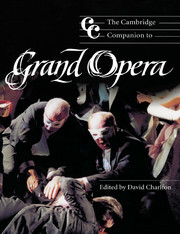Book contents
- Frontmatter
- 1 Introduction
- Part I The resourcing of grand opera
- Part II Revaluation and the twenty-first century
- Part III Grand operas for Paris
- Part IV Transformations of grand opera
- 16 Richard Wagner and the legacy of French grand opera
- 17 Grand opera in Russia: fragments of an unwritten history
- 18 Grand opera among the Czechs
- 19 Italian opera
- 20 Grand opera in Britain and the Americas
- Notes
- Select bibliography
- Index
19 - Italian opera
from Part IV - Transformations of grand opera
Published online by Cambridge University Press: 28 November 2011
- Frontmatter
- 1 Introduction
- Part I The resourcing of grand opera
- Part II Revaluation and the twenty-first century
- Part III Grand operas for Paris
- Part IV Transformations of grand opera
- 16 Richard Wagner and the legacy of French grand opera
- 17 Grand opera in Russia: fragments of an unwritten history
- 18 Grand opera among the Czechs
- 19 Italian opera
- 20 Grand opera in Britain and the Americas
- Notes
- Select bibliography
- Index
Summary
Grand opera and opera-ballo
The formative phase of post-Verdian grand opera spanned more than twenty years. Among its earliest notable works was Mefistofele by Arrigo Boito (1868): provocative and iconoclastic, this opera swept away many rules or ‘formulas’ (as its composer disparagingly called them) of traditional opera. This explains why its first performance at La Scala, Milan was a complete failure. However, Italian assimilation of French grand opera had already matured as a result of three factors: aesthetic discussions in the press, vigorous publishing and promotion policies by the firms of Ricordi and Lucca, and various theatre managements open to new European products. This assimilation can be traced back several decades. The writing of (grand operas' continued into the early 1890s, as shown in Table 19.1. The last of these works are contemporary with the first attempts at a new genre, one which was to be an antithesis in many (but not all) of its attributes: ‘verismo’ opera. Verismo's dramatic norms were instead based on narrative concision, unobtrusive structure and the absence of dance.
Among the last Italian grand operas were Cristoforo Colombo (1892) by Alberto Franchetti, based on the adventures of the discoverer of the New World; and I Medici (1893) by Ruggero Leoncavallo, actually the first part of an unfinished operatic trilogy on the Italian Renaissance entitled, with deliberate Wagnerian echoes, Crepusculum. In Cristoforo Colombo the grandiose scale, with crowd scenes, dances and pezzi concertati in Acts III and IV, was prompted by a particular festive occasion: the 400th anniversary of the discovery of America.
- Type
- Chapter
- Information
- The Cambridge Companion to Grand Opera , pp. 383 - 402Publisher: Cambridge University PressPrint publication year: 2003

